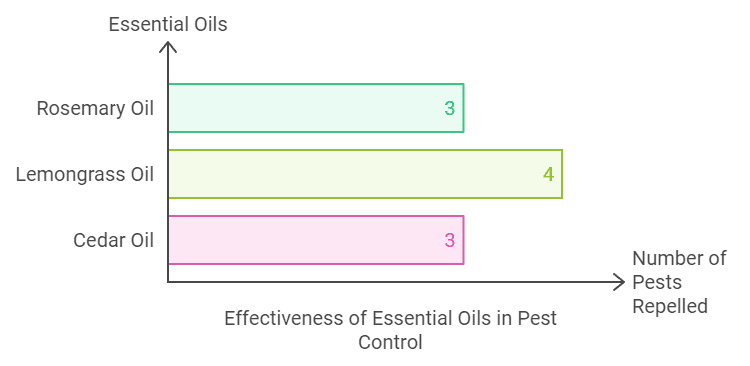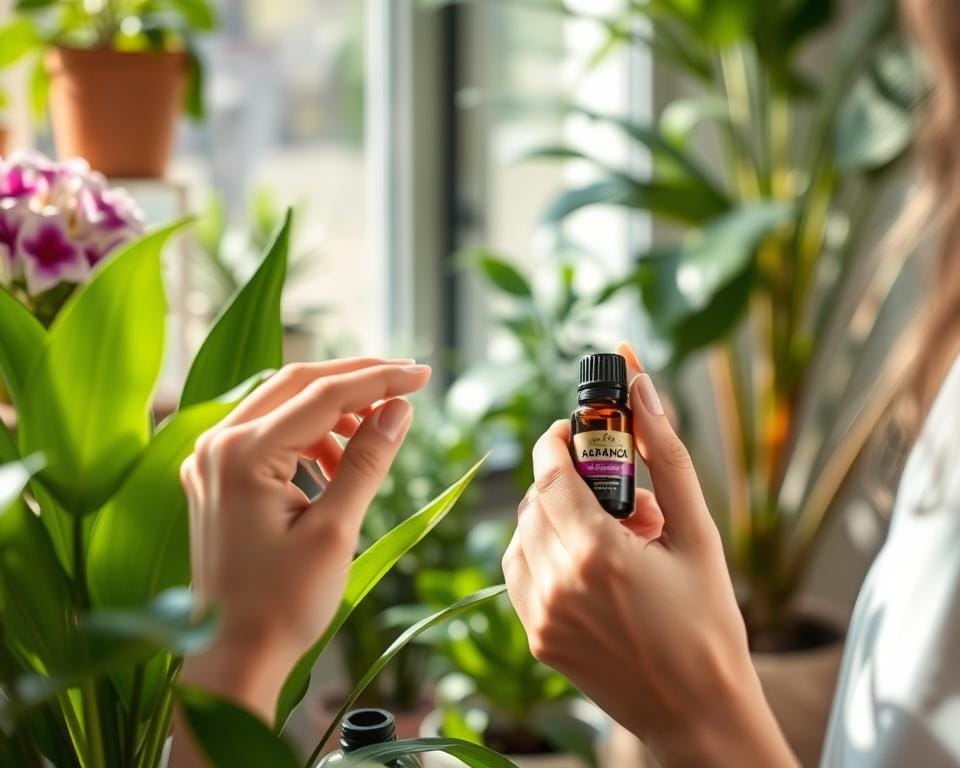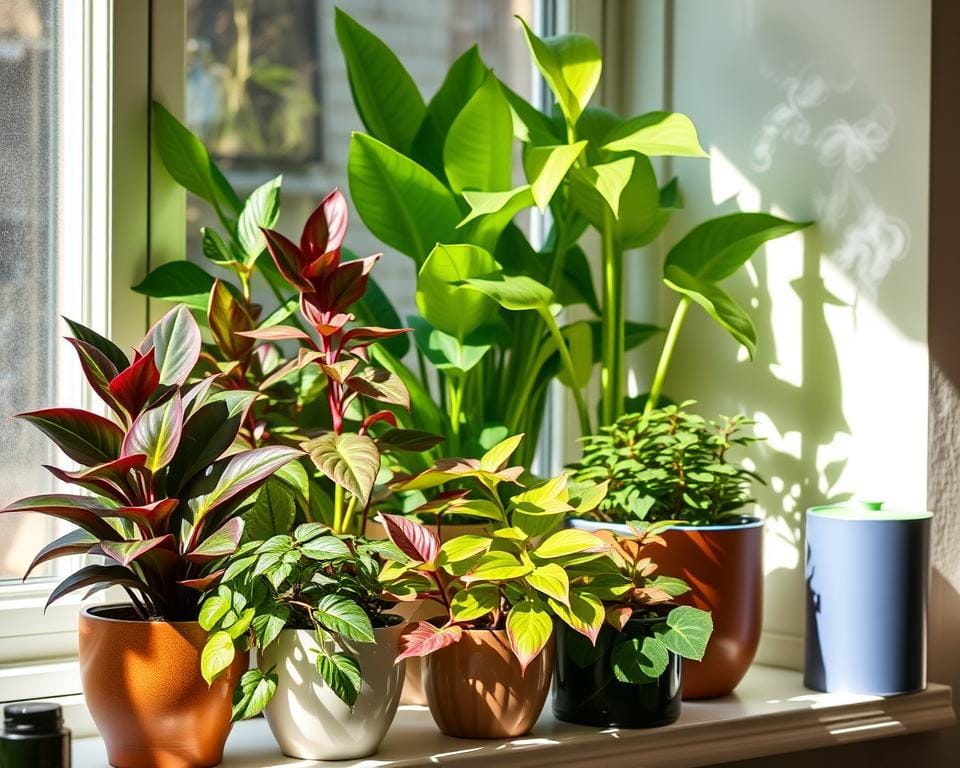Are you curious about using nature’s power to boost your indoor plants? You’re in the right place as we’re about to share how to use essential oils for your houseplants. Whether you love plants or are just starting, learning about essential oils can change the game for your indoor garden’s health and vitality.
Key Takeaways
- Discover the surprising ability of common indoor plants to produce essential oils that can benefit your home environment.
- Learn how to harness the natural pest-repelling and growth-promoting properties of essential oils for your potted plants.
- Explore the various methods of incorporating essential oils into your plant care routine, from misting to soil treatments.
- Uncover the science behind the synergy between essential oils and the natural defenses of plants.
- Gain insights into creating your own custom essential oil blends for targeted plant care needs, such as pest control and disease prevention.
The Benefits of Using Essential Oils for Indoor Plants
Essential oils are becoming more popular for taking care of indoor plants. They are natural and work well. These oils help your plants grow and stay healthy.
Essential Oils as Natural Pest Repellents
Essential oils keep indoor plants safe from pests. Oils like lemongrass, cedar, peppermint, and rosemary keep away ants, ticks, flies, slugs, and mosquitoes. These oils make it hard for pests to live near your plants.
Essential Oils for Promoting Plant Growth and Health
Essential oils do more than just keep pests away. They help plants grow and stay healthy. Geranium oil makes leaves look better and plants stronger. Clove and tea tree oil fight off fungus on plants. Using essential oils wisely helps your plants live longer and grow better.
| Essential Oil | Benefits for Indoor Plants |
|---|---|
| Lemongrass | Repels mosquitoes, ants, and spiders |
| Peppermint | Deters bugs and spider mites |
| Rosemary | Combats fungal growth and prevents damage from spider mites |
| Lavender | Serves as an insecticide and promotes a calming environment |
| Clove | Possesses anti-inflammatory and antimicrobial properties to combat fungal growth |
Using essential oils in your plant care routine has many benefits. You get natural pest control, better plant health, and a beautiful garden indoors.
Top Three Essential Oils for Indoor Plants
Three essential oils are great for keeping indoor plants healthy: rosemary, lemongrass, and cedar oil. They help with pest control, boost plant growth, and attract pollinators.
Rosemary Oil
Rosemary oil keeps pests like flies, ticks, and mosquitoes away. It also draws in bees and butterflies, helping your plants grow. Use it in a diffuser for a nice smell and pest protection.
Lemongrass Oil
Lemongrass oil keeps spiders, fleas, mosquitoes, and more away from your plants. It also makes plants grow better and smell fresh. The scent of lemongrass oil can make your space feel more welcoming.
Cedar Oil
Cedar oil is a strong protector for indoor plants. It keeps pests like mollusks, moths, and aphids away. Its earthy smell can make your indoor garden feel calm and cozy.

Using these essential oils in your plant care can help control pests naturally. It also boosts your plants’ health. Try different ways of using them to find what works best for you.
How to Use Essential Oils from Indoor Plants
Using essential oils for your indoor plants is great, but remember they’re very strong. You need to mix them with something else before putting them on your plants. This way, your plants get the good stuff without getting hurt.
To use essential oils on your indoor plants, just follow these steps:
- Dilute the essential oils. Mix a few drops of the oil with water in a spray bottle or container. The usual mix is about 1-2 drops of essential oil per 1 ounce of water.
- Apply the diluted mixture. Spray or mist the mix gently over your plants’ leaves and soil. Don’t soak the plants.
- Diffuse the essential oils. Put a few drops of the oil in a diffuser. Let the scent spread around your plants. It can help them grow and stay healthy.
- Monitor your plants. Watch how your plants react to the essential oils. If some are too sensitive, adjust the amount you use.
Always keep your essential oils in a cool, dark spot. And always read and follow the bottle’s instructions. With some trial and error, you’ll find the best way to use essential oils for your plants. This will help your plants thrive and make your home healthier.

“The right essential oil can be a game-changer for your indoor plants, but it’s all about finding the right balance.”
Understanding the Science Behind Essential Oils and Plants
Essential oils in the garden come from the amazing science between plants and their defenses. Plants have special ways to keep pests, diseases, and stress away. Essential oils are a big part of this defense.
Plants’ Natural Defenses and Essential Oils
Essential oils are made by plants to keep pests away and stay healthy. They have different chemicals like terpenes and phenols. These help the plant stay well.
By learning about these defenses, we can use essential oils to help our indoor plants grow strong.
The Transferability of Healing Properties
Essential oils can share their healing powers with plants and even people. This is because plants and humans are similar in our biology. Using essential oils on plants is like helping them use their own defense systems.
The study of essential oils and plants is very interesting. It shows how these natural substances can help plants and people. By understanding this, we can make our indoor gardens healthy and full of life.
“Essential oils are the lifeblood of plants, serving as their natural defense against pests, pathogens, and environmental stressors. By harnessing their power, we can support the health and vitality of our indoor plants.”
Pest Repellent Recipe for Indoor Plants
Creating a natural pest repellent for your indoor plants is easy and effective. It keeps common pests away without using harsh chemicals. Here’s a simple DIY recipe to protect your houseplants.
To start, gather these ingredients:
- 2 tablespoons of Castile soap or On Guard Cleaning Concentrate
- 10 drops each of peppermint, lavender, cedarwood, and lemongrass essential oils
- 16 oz glass spray bottle
- Water
Mix the Castile soap or On Guard Cleaning Concentrate with the essential oils in the spray bottle. Add water and shake well. This natural pest repellent for indoor plants will keep pests like ants and slugs away.
Just spray it on your plants weekly. Use it on leaves, under leaves, and soil. This DIY pest control for houseplants is safe and keeps pests away.
Always test essential oils on a small area first to check for plant reactions.
This easy pest repellent keeps your indoor garden healthy and pest-free. Enjoy the benefits of essential oils and happy plants.
Fungus Suppressant Recipe for Indoor Plants
Dealing with fungal issues in indoor plants can be tough. But, you can make a natural solution at home. Essential oils let you create a fungus suppressant spray. This keeps your houseplants healthy and thriving.
Tea tree oil is great for fighting plant fungus. It’s a natural antifungal that stops many fungal pathogens. To make the spray, mix 20 drops of tea tree oil with an 8-ounce bottle of water.
- Gather your ingredients: 20 drops of tea tree oil and an 8-ounce bottle filled with water.
- Combine the tea tree oil and water in the bottle, then shake well to mix thoroughly.
- Mist the top and underside of leaves, stems, and soil of your indoor plants.
- Apply the spray in the early morning after watering to avoid any potential sun scald.
- Use the fungus suppressant spray weekly or as needed for plants prone to fungal issues, such as tomatoes, squash, cucumbers, melons, grapes, bee balm, lilacs, and fruit trees.
This simple, natural fungus control for houseplants can help you say goodbye to unsightly fungal growth. Your indoor plants will thrive with this DIY fungus suppressant. The essential oils for plant fungus in this recipe are an eco-friendly way to keep your plants healthy.
“Using essential oils like tea tree oil is a great way to naturally combat fungal issues in your indoor plants without resorting to harsh chemicals,” says Lisa Eldred Steinkopf, the guest author for the podcast episode “Watering the garden, using Essential oils in & out of the garden” on The Wisconsin Vegetable Gardener.
Weed Killer Recipe Using Essential Oils
Weeds can be a big problem in gardens and outdoor areas. But, you don’t need harsh chemical weed killers. You can make a natural weed killer with essential oils and pantry items. This method is good for the environment and works well to get rid of tough weeds.
To make your own weed killer with essential oils, mix 10 drops of cinnamon bark oil in an 8-ounce spray bottle. Then, fill the bottle with either water or white vinegar. Vinegar is great at killing weeds because it dries them out quickly.
For a stronger DIY weed control spray, add 1 1/3 ounces of Dr. Bronner’s liquid castile soap and 3 drops each of wintergreen, clove, cinnamon, and orange essential oils. This mix makes a powerful weed killer using essential oils that works on hard weeds.
When you spray the solution, aim it right at the weeds. Make sure they get soaked, especially on a hot day when the soil is dry. This helps the solution work better. Keep spraying until the weeds are gone.
This weed killer recipe is not only effective but also cheap. With a gallon of white vinegar and some essential oils, you can make a lot of weed killer. It’s much cheaper than buying commercial weed killers.
Remember, this natural weed killer is safe for your plants. But, don’t spray it on any plants you want to keep. Using this DIY weed control method lets you kill weeds without hurting the environment or your garden.
Using Companion Plant Essential Oils
Companion planting means growing plants together for mutual benefits. Using essential oils can boost these benefits. Add 5 drops of the right oil to a 2-gallon watering can. Then, water the soil around the plants. This can keep pests away, boost immunity, and make plants grow better and taste better.
Companion Planting and Essential Oils
Studies show that 100% of essential oil users find them helpful for gardening. In fact, people who use essential oils at home also use them in their gardens. This shows how effective essential oils are for both home and garden.
How to Use Companion Plant Essential Oils
- Use a ratio of 1:1 when applying essential oils for various solutions at home and in the garden.
- 100% of essential oil users facing bug infestations in their gardens have effectively solved the problem using essential oils.
- The effectiveness of essential oils on different bug types ranges from 75% to 100%.
- 100% of essential oil users incorporate them in plant care for fungal and bacterial issues, with tea tree oil, Thieves oil, oregano oil, and cinnamon oil being particularly effective.
- 100% of individuals using essential oils have reported enhanced flavors of their home-grown produce.
Many gardeners use companion plant essential oils often. The effectiveness of essential oils on different plants can vary. So, it’s key to research and experiment to find the best pairings for your garden.
Attracting Pollinators with Essential Oils
Gardeners and plant lovers can use essential oils to draw bees and butterflies to their gardens. By picking the right oils, you can make a space that helps plants grow and supports many species.
Essential Oils for Attracting Bees
Bees are key to many plants’ ability to reproduce. To get these busy insects to visit, try using wild orange, lavender, marjoram, helichrysum, basil, and rosemary. These oils smell like the flowers bees love.
Essential Oils for Attracting Butterflies
Butterflies are not just pretty; they help pollinate plants too. To draw these lovely creatures, use lavender, fennel, and helichrysum. Mix these oils into a spray to put on your flowers and around them.
To make a pollinator spray, put 10 drops of oil in an 8-ounce bottle with water. Spray it on your plants and the area around them. This simple spray can make your garden a lively place for pollinators.

“Bees play a crucial role in successful pollination; therefore, declines in bee populations could have substantial economic and environmental repercussions.”
Adding essential oils to your plant care can make your garden a great place for pollinators. Try different oils and see which ones work best at bringing in the pollinators you want.
Conclusion
Essential oils from indoor plants offer many benefits for both plant health and wellness. They can keep pests away, help plants grow, and fight fungus. These natural compounds are easy to add to your plant care routine.
By learning about homegrown aromatherapy and simple DIY recipes, anyone can use essential oils to make their indoor gardens thrive. Essential oils are a great way to keep your plants healthy and smelling nice.
Looking to keep pests away, boost plant growth, or just enjoy the scent? Essential oils are a great choice for DIY plant care. They work by interacting with plants in a special way. With a bit of creativity and a love for gardening, essential oils can make your plants look and smell amazing.
As you explore homegrown aromatherapy, always remember to be safe and informed. With the right knowledge and care, essential oils can make your indoor garden beautiful and healthy. They can also make your home smell great and improve your well-being.
FAQ
What are the benefits of using essential oils for indoor plants?
Essential oils help indoor plants by keeping pests away and making them grow strong. Oils like lemongrass and cedar keep bugs such as ants and mosquitoes off. They also help fight fungal diseases and wake up sick plants. Geranium oil makes leaves look better.
What are some of the top essential oils for indoor plants?
Top essential oils for indoor plants include rosemary, lemongrass, and cedar oil. Rosemary oil keeps flies and mosquitoes away and attracts bees. Lemongrass oil keeps spiders and mosquitoes off and helps plants grow.
Cedar oil keeps slugs and moths away by messing with their behavior.
How do I use essential oils for my indoor plants?
Mix essential oils with water before putting them on plants. You can spray it on or put a stick with oil in the soil. You can also use a diffuser near your plants. Always follow the oil bottle’s instructions and keep them in a cool, dark place.
What is the science behind using essential oils for indoor plants?
Essential oils are natural defenses of plants. They help plants fight off pests and heal themselves. Since plants and humans are both living things, these oils work well for both. Using essential oils helps plants grow strong.
Can I make my own natural pest repellent and fungus suppressant sprays using essential oils?
Yes, you can make your own sprays with essential oils. For a bug spray, mix 2 tablespoons of On Guard or Castile soap with 10 drops of peppermint, lavender, cedar, and lemongrass oils in a spray bottle. Fill it with water. For fighting fungus, use 20 drops of tea tree oil in an 8 oz bottle with water.
Can I use essential oils to create a natural weed killer?
Yes, a natural weed killer can be made with 10 drops of cinnamon bark oil in an 8 oz spray bottle. Fill the rest with water or vinegar. Use it on paths and driveways, but be careful not to spray it where you want plants to grow.
How can I use essential oils for companion planting?
Companion planting gets better with essential oils. Add 5 drops of the right oil to a 2 gallon watering can. Water the soil around your plants to keep pests away and help them grow better.
Can I use essential oils to attract beneficial pollinators to my indoor garden?
Yes, essential oils can draw bees and butterflies to your garden. Use oils like wild orange and lavender for bees. For butterflies, try lavender, fennel, and helichrysum. Mix 10 drops of the oil with water in an 8 oz spray bottle and mist your plants.
Sources:
Essential Oils and Your Indoor Plants
10 Essential Oils For Thriving Indoor Plants







